• Press or to scroll
through the days of the
week pressing SELECT
to begin reviewing or
adjusting the time and
temperature settings for
that particular day. "Hour"
is now flashing to indicate
that it is the selected item
to be adjusted.
Manual Issue No. IM-T105NP-002
RF Programmable
Room Thermostat
1 3 4 5 6 7 8 9 10 11 12 13 14 15 16 17 18
Warning - Please read this manual prior to
installation or use.
Shock Hazard
This unit must be installed by a competent
person, in accordance with BS 7671 (the IEE
Wiring Regulations), or other relevant national
regulations and codes of good practice.
Always isolate the AC Mains supply before
installing this unit.
INTRODUCTION
INTRODUCTION
This thermostat can replace most common
residential thermostats and is designed to be used
with electric, gas or oil heating control system or
cooling system.
Unlike ordinary single unit design thermostats,
This is a new type of thermostat separating the
operational functions into two units. The Receiver
serves for wiring connections and heat/cool on/off
control. The Control Centre serves as user interface
and temperature sensing/control. The two units are
linked by Radio Frequency.
The advantage is that user can put the Control
Centre nearby and can read/control the temperature
of the actual living area.
Outlook of Control Centre:
LCD Display:
19 20 21 22
Instruction Manual
2
Frost Protection
Button
Set Button
Select Button
Reset Button’
Up Button
Down Button
Back-Light Button
SET
SELECT
Day
Programme No. Indicator
Time
Heat / Cooler On Indicator
Frost Protection
Temperature
Low Battery Indicator
Set Programme indicator
Front cover
LED
Indicators
Power
switch
Front inside view
ON
OFF
Outlook of receiver
Features:
Several useful function and operating modes have
been incorporated to suit a variety of customer
needs besides all the features associated with the
state of the art programmable thermostat.
Control Centre:
- Can be placed anywhere in the home to detect
and control the temperature of an area of the
user’s choice. Not limited by power control wiring
locations.
- Link with the Receiver via RF. Control distance
60M open site
- LCD shows the "need to know" information
only, which is easier to understand.
- Real time clock with day of the week display
- Room temperature display
- Programme set-point display
- Simplified temperature adjustment - Simplified
programming procedure
- Default factory preset programme from start up
or reset
- 5-2 or 7 day programming
- Frost Protection preset at 5˚C
- Temporary override set-temperature
- User selectable temperature span
- User selectable heater/cooler operation mode
- Battery level detection
- 2 AA size alkaline batteries
- Slim housing design
- EL backlight
Receiver:
- Linked with Control Centre via RF.
- Power control rating 230V AC up to 16A resistive.
- Powered by line voltage only. No battery required.
- Two LED indicators for power and output status.
INSTALLATION OF RECEIVER
Caution :
1) Remember to Isolate AC mains supply, note this
must be 230V AC and fused at 13 amps max.
2) Select a suitable indoor location free from water
and moisture.
3) The receiver should not be shielded from the RF
signal in any way, follow ‘Testing the RF Transmission’
section of this manual before deciding on a final
location for the receiver and control centre units.
4) To access the wiring terminals carefully prize off the
front cover from the top middle of the receiver with
a flat head screw driver and remove the 2 screws
underneath as illustrated in the diagram on page 2
of this Manual.
5. Observe the nation regulation for the wiring.
A qualified electrician is recommended for
installation and servicing.
This thermostat has been designed for simple and
quick installation requiring only a few tools. Only
the Power Control Unit needs to be installed.
Required Tools
• Hammer • Masking tape • Screwdriver
• Drill and 3/16" drill bit
(if not installed on a junction box)
RF Address Code Setting
If there is another user nearby, e.g. in the next
house, your receiver may be triggered by their
transmitter. You may select a different RF address
code to prevent this. The receiver can only response to
RF coding with the same address code setting as its
own.
1. To adjust address code of Receiver, simply push up
one or more of the 5 dip switch levers .
2. To adjust the address code of the Control Centre,
open the housing of control centre as illustrated in
the diagram on page 10 of this manual.
3. Remove one or more of the jumper caps as shown
in the diagram on page 6.
Caution :
1. Address code of Control Centre must be the same
as address code of Receiver. For any jumper cap
removal of address code # in Control Centre, same
address code # of Receiver must be put to the UP
position.
2. Disconnect AC power and remove batteries before
adjusting address code.
Note that RESET button must be pressed after removing
any of the jumpers on the Control Centre.
Remove one or more
of the jumper cap to
adjust RF address
code.
Address code # 1 - 5,
from left to right
Push up one or more of
the white levers to adjust
Receiver address code.
Address code # 1 - 5,
from left to right.
WARNING: After removing the wall plate, if you
find that it is mounted on a junction box (e.g. a box
similar to one behind a light switch or electric
outlet), high voltage circuit may be present and
there is a danger of electric shock. Please consult a
qualified electrician.
Choosing a Location for the Control Centre
The Control Centre can be mounted to a wall using
the screws provided or can left in a convenient
location to monitor your living area using the units
integrated stand.
Mounting the Receiver onto the
wall/junction box:
1. Remove the front cover of the Receiver. (go to
step 4 if installed on a junction box)
2. Mark the holes position.
3. Drill two holes and insert the plastic anchors
carefully into the holes until they are flush with the
wall.
4. Connect the wires - see wiring diagram.
5. Push on the wires in the wall.
6. Securely fasten the Receiver to the wall with the
two screws.
7. Replace the front cover and installation is
completed.
Mounting the Receiver onto the
optional wall box :
1. Remove the front cover of the Receiver.
2. Mark the holes position for the wall box.
3. Drill two holes and insert the plastic anchors care
fully into the holes until they are flush with the wall.
4. Pull the wires into the wall box and fasten the
wall box onto the wall.
5. Connect the wires - see wiring diagram.
6. Push on the wires in the wall box.
7. Securely fasten the Receiver to the wall box with
the two screws.
8. Replace the front cover and installation is completed.
SETTING OF
CONTROL CENTRE
Before making any
selection in the
control centre, It’s
back housing must
be removed as
follows :
Inside the Control Centre after back housing is
removed, you can find the DIP switch. These four
switches are used to control the span, heat/cool mode
and 7 or 5/2 program selection.
Heater/Cooler Selection
Set the DIP switch (position 3) according to your
selection of heater system or cooler system as
indicated in the following diagram.
Temperature Span Selection
Span is the temperature difference between the turn
on temperature and turn off temperature. For example,
in heating system, if you set temperature to 20°C
and span to 1°C, the heater will operate when the
room temperature drops to 19.5°C and turns off when
the temperature rises to 20.5°C. Set the DIP switch
(position 1 & 2) according to your selection of
temperature
span as indicated in the following diagram.
1
ON
OFF
ON
OFF
2
ON
ON
OFF
OFF
Span
0.5
O
C
1.0
O
C
1.5
O
C
2.0
O
C
1 2 3 4
Set the DIP Switch (Position 1 & 2)
Set the DIP Switch
(Position 4)
5-2 or 7 Day Programme Selection
The Control Centre is capable of operating with a 5-
2 or 7 day program setting. 5-2 allows you to set one
program for weekdays and another for the weekend.
7 day programming allows a different program to be
set for each day of the week. Set the DIP switch (position
4) according to your selection of program as indicated
in the following diagram.
The following table is the setting of the
thermostat after reset or Power on:
Battery Installation
Your thermostat uses 2 x "AA" size Alkaline batteries to
operate. To power-up the unit, insert two "AA" batteries
into the battery compartment of the front housing.
When power is applied for the first time, the
display must show time and the day as well as the
room temperature (for example 28.5°C).
If the display is different,
press the RESET button.
Use a fine probe such as
straightened paper clip to
gently push the RESET button.
Function Status after Reset or Power on
Operation Mode Normal mode
Room Temperature 22.0°C, to be renewed within 5 seconds
°C indicator On
Clock 12:00
AM/PM indicator AM
Day of Week indicator M
Program Default factory setting
Set-point Temperature Default factory setting
Program indicator Number 1
SET indicator Off
PROG indicator Off
Frost Protection indicator Off
Heat indicator Off
Low-Battery Off, to be renewed
Warning indicator within 5 seconds
Output Relay Off
After reset or power on, the thermostat will operate in
Normal mode. Set-point temperature is reset to default
setting. Room temperature is updated in 5 seconds and
the control process starts. Program Number is updated
to indicate the running program.
1 2 3 4
Note that the
RESET button must
be pressed after
altering any DIP
switch position on
the Control Centre.
ON: 5-2 day programming
Off: 7 day
programming
1 2 3 4
Set the DIP Switch (Position 3)
ON: Heater
OFF: Cooler
Key Function Guide
Increase Set-point Temperature
Decrease Set-point Temperature
Turn on backlight for 5 seconds
Activate/Deactivate Frost Protection
SET Key for Clock/Program settings
SELECT Key for Clock/Program settings
SET
SELECT
Setting The Clock
• Press and hold SET and SELECT in Normal mode
for 3 seconds to enter Clock setting mode.
• Clock, Day-of-Week, and
"SET" are displayed.
All other indicators are
cleared. "Hour" is flashing to
indicate that it is the selected
item to be adjusted.
• Release SELECT, press or to increase or
decrease the "hour" respectively.
• Press and release SELECT, press or to increase
or decrease the "minute" respectively.
• Press and release SELECT, press or to cycle
the Day of Week from "M" to "SU".
• Press and release SELECT to allow change of "hour"
again.
• Press and hold or for 2 seconds to enter fast
advance in 4Hz.
• Selected item will stop flashing when a key is pressed.
The selected item will flash again once the key is
released.
• Press SET at any time to confirm the setting and
return to normal mode.
• Thermostat will return to normal mode if no key
pressed for 15 seconds, Clock is also updated with
the latest setting.
Programming Your Thermostat
The control Centre has a built in factory default program
setup which is operational after initial power up or
reset. The default program is as follows.
Program Weekday (M to F) Weekend (SA to SU)
1 Time: 6:00am Time: 6:00am
Set-point Temp: 21°C Set-point Temp: 21°C
2 Time: 8:00am Time: 8:00am
Set-point Temp: 17°C Set-point Temp: 21°C
3 Time: 4:00pm Time: 4:00pm
Set-point Temp: 21°C Set-point Temp: 21°C
4 Time: 6:00pm Time: 6:00pm
Set-point Temp: 21°C Set-point Temp: 21°C
5 Time: 10:00pm Time: 10:00pm
Set-point Temp: 17°C Set-point Temp: 17°C
Setting Your own Program
5-2 days programming selected
• 5 different sets of Time and Set-point temperature
can be set for the Weekdays or the Weekend.
• To review or change program, press SET in Normal
mode to enter Program Setting mode. Program
1 of the Weekday, and "SET PROG" are displayed.
All other indicators are cleared. "Weekday" is
flashing to indicate that it is the selected item to
be adjusted.
• Press or to scroll between Weekday & Weekend
pressing SELECT to begin reviewing or adjusting
the time and temperature settings. "Hour" is now
flashing to indicate that it is the selected item to be
adjusted.
• Use or to change any settings as required
before pressing SELECT to scroll to the next
setting.
• The time and set-point temperature settings will be
scrolled through in the below sequence.
(Program 1) "Hour" "Minute" Set-point temp
(Program 2) "Hour" "Minute" Set-point temp
(Program 3) "Hour" "Minute" Set-point temp
(Program 4) "Hour" "Minute" Set-point temp
(Program 5) "Hour" "Minute" Set-point temp
and then cycle back to (Program 1)
Press SET at any time to confirm the settings and
return Weekday/Weekend selection, pressing SET again
will accept settings and exit programming.
7 Days Program Selected
• 5 different sets of Time and Set-point temperature
can be set for each individual Day of the Week.
• To review or change the program, press SET in
Normal mode to enter Program Setting mode.
Program 1 of Monday, and "SET PROG" are displayed.
All other indicators are cleared. "Day of Week" is
flashing to indicate that it is the selected item to be
adjusted.
• Use or to change any
settings as required before
pressing SELECT to scroll
to the next setting.
• The time and set-point
temperature settings will
be scrolled through in the
below sequence.
(Program 1) "Hour" "Minute" Set-point temp
(Program 2) "Hour" "Minute" Set-point temp
(Program 3) "Hour" "Minute" Set-point temp
(Program 4) "Hour" "Minute" Set-point temp
(Program 5) "Hour" "Minute" Set-point temp
and then cycle back to (Program 1)
Press SET at any time to confirm the setting and
return to day selection, pressing SET again will accept
settings and exit programming.
TESTING THE RF TRANSMISSION
It is important to site the Receiver and Control Centre in
locations where the RF signal cannot be interrupted. The
receiving range between Control Centre and Receiver is 60M
in open area. Many factors can affect the RF transmission,
shortening the operating distance e.g. shielding by thick walls,
foil back plasterboard, metal objects such as filing cabinets,
general RF interference etc, However, the range is enough for
most household applications.
It is advisable to test the RF transmission from the
intended Control Centre location to the Receiver location
before fixing the Control Centre to the wall.
1. Press UP button until the set-point temperature is
higher than room temperature by a few degrees.
2. Wait for a few seconds. The animated fan (heat/cool call
indicator) should appear on the bottom left of
the LCD on the control centre.
3. Check the green LED on the receiver unit. It should
be illuminated.
4. Press Down button to adjust the set-point
temperature to be lower than room temperature. Wait
for a few seconds. The animated fan (heat/cool call
indicator) should disappear and the green LED should
switch off
5. If at step 3 the LED is not illuminated, Press Down
button to adjust the set-point temperature to be lower
than room temperature to stop the unit calling for
heat. Try to place the Control Centre closer to the
Receiver, repeating steps 1 to 4.
6. Alternatively you can try and alter the address code
following the ‘RF Address Code Setting’ section of this
manual, then repeat steps 1 to 4.
Note that the RESET button on the Control Centre
should be pressed after altering the address code.
23 24 25 26
Multiple Thermostat Installations
Please note, if using more than one Thermostat
in the same installation, be sure that there is
at least a 1 metre gap between receiver units
to avoid RF interference.
When installing multiple thermostats you should ensure
that you assign different address codes for each unit
following the ‘RF Address Code Setting’ section of this
manual. Each thermostat should be introduced to the
installation one at a time with all other receiver units
switched off, also make sure that the batteries are
removed from all other Control Centres.
Install each unit following the ‘TESTING THE RF
TRANSMISSION’ section of this manual. Once you are
happy with the operation of one unit you may install
the next. Once all thermostats are installed, if one unit
then seems to function abnormally, try changing the
address code of the control centre & its corresponding
receiver again taking care that the new code given is
different to all others in the installation.
The control centre sends RF On/Off signals every 10
min to ensure the receiver is in the correct state. If for
some reason the 1st RF signal is interrupted you may
notice the control centre has started/stopped calling
for heat but the receiver hasn’t switched. Simply wait
10 minutes until the next RF signal is transmitted and
the receiver unit should switch.
Reviewing Set-point Temperature:
• Press or to review
the Set-point temperature.
• When any of the programs
are running, the LCD will
show the program Set-
point temperature with
the "SET" indicator
displayed.
•When operating in Frost
protection mode, the
LCD will show 5°C with
the Frost Protection
indicator displayed.
• When operating in
Temporary Override
mode, the LCD will show
the temporary Set-point
temperature.
• Press any key except or ,
or wait 3-4 seconds without
key press to return to
normal mode, room
temperature will be displayed.
Temporary Override:
• Press or again when reviewing Set-point
Temperature to enter Manual Override mode, the
Set-point Temperature is increased or
decreased by increments of 0.5°C accordingly.
• In Normal mode, press and hold or to display
the Set-point temperature. After 2 seconds, the
Thermostat will enter Manual Override mode and
start fast advance at 4Hz. If buttons are released
within 2 seconds, this is treated Set-point Temperature
review only.
• Clock, Day-of-Week, and
"SET" are displayed During
temporary override with all
other indicators cleared. The
Set-point temperature will
flash to indicate it can now
be changed.
The setting range is 10°C - 35°C in increments of 0.5°C.
• Set-point Temperature will stop flashing when a key is
pressed, then flashes again once the key is released.
• Press SET at any time to confirm the setting and return
to normal mode.
• Thermostat will return to normal mode after 3-4
seconds if no key is pressed. Temporary override remains
active until clock or program setting are adjusted, Frost
protection is activated or the next program time /
temperature set-point is reached.
Time Display :12 hour/24 hour
Clock Accuracy :+/- 1 min/month
Air conditioner cycle time :3 minutes
Memory :Memory hold up: 5 minutes
Back Light :Blue colour EL Panel
Battery Low Warning :2.6 - 2.8V
Operating Humidity :0 to 90% RH/non condensing
Protection :Auto cut off at over 35°C
(heating mode)
Auto Cut of at under 10°C
(cooling Mode)
Micro disconnectionType 1.B control action
on operation :
Rated Impulse Voltage :4kV
Storage Conditions :-20°C - 55°C to 90%
RH/non condensing
Agency Approval :CE
Frost Protection (in Heat Control only):
•Press FROST in Normal mode to activate the Frost
Protection.
•The Set-point temperature is automatically set to
5°C to prevent frosting.
•Whenever the Frost Protection is activated, the Frost
Protection indicator is animated with the below
sequence in 4Hz.
•Press FROST again to deactivate the Frost
Protection, the Frost Protection indicator will turn
off.
27282930
BATTERY REPLACEMENT
It is recommended to replace the batteries when the
display is showing the battery-low icon. To replace
the battery,
1. Turn off the power of the Receiver first.
2. Remove the back housing (as illustrated on Page 10)
3. Replace the old batteries with 2 new AA alkaline
batteries.
4. Replace the back housing and stand.
5. Press the reset button once and then turn on the
power switch of the Receiver.
POWER SWITCH
There is a power switch on the Receiver. When there
is no demand to turn on the heating/cooling device,
e.g. when you go on holiday, it is recommended to
turn the power switch to the Off position.
LED INDICATOR
There are two LED’s on the Power Control Unit as
status indicators:
1.The Red LED Illuminates when the unit is receiving
A 230V AC feed and the power switch is in the On
Position.
2.The Green LED Illuminates up on receiving a call
signal from the Control Centre to indicate the heating/
cooling device is energised.
Push and hold
internal lock with
a screw driver
Remove
the front
housing
ON
OFF
After installation of the
batteries, push back the
rear housing to the control
centre and then the stand.
Before turning on the main
switch of the system, press
the reset button once. The
thermostat is ready for use.
WIRING DIAGRAM FOR 230V APPLICATION
The unit is default 230V, if volt free application is required
you must remove link & follow wiring diagram for volt free
appication.
WIRING DIAGRAM
FOR VOLT FREE APPLICATION
(Remove Link!!!)
The unit still requires a 230V feed for V.F. applications
NO - Switched Live (Volt Free)
COM - Volt Free Feed
NC - Normally Closed*
N - Neutral
L - Live (230V Feed)
SL (Off) - Heat Off*
L - Live
SL (On) - Heat On
N - Neutral
It is vital to connect the live into
this terminal to avoid overloading
of the jump wire.
* Not normally used.
WIRING INTO THE EXTERNAL
THERMOSTAT LOOP OF A BOILER
(Remove Link on Receiver & External
Thermostat Link on Boiler!!!)
The unit still requires a 230V Permanent Live feed
Removing your old thermostat
CAUTION : to avoid electric shock, isolate the power
of the heating/cooling system at the main power box
in your home. Read the following instructions carefully
before disconnecting the wires.
1. Turn off your old thermostat.
2. Remove the cover from the old thermostat.
3. Unscrew the old thermostat from the wall plate.
4. Now find the screws attaching the wall plate to the
wall, and remove them. You should now be able to
pull the wall plate a small distance from the wall. Do
not disconnect any wire yet, simply locate the wires.
It is advisable to choose a location about five feet
(1.5 metre) above the floor in an area with good
air circulation and away from.
1. Drafts.
2. Air ducts.
3. Radiant heat from the sun or appliances.
4. Concealed pipes and chimneys.
Your chosen location should allow a clear signal to
reach your receiver with nothing interrupting or
interfering with the RF transmission. Please follow
‘Testing the RF Transmission’section of this manual
when considering where to locate your Control Centre.


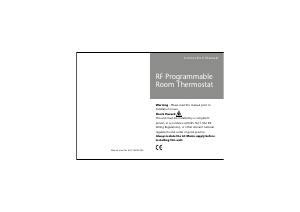

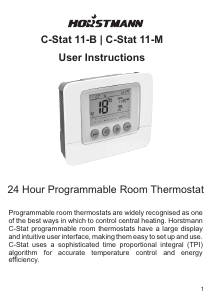
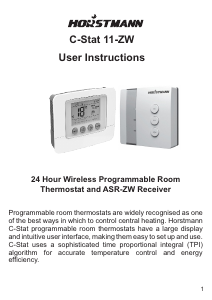
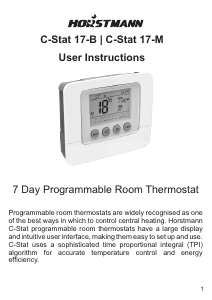
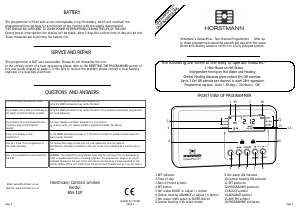
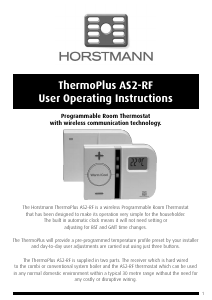
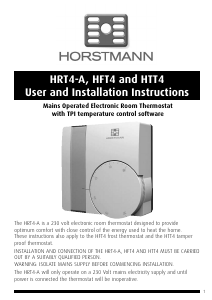
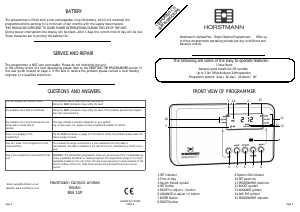
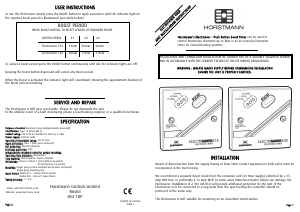
Join the conversation about this product
Here you can share what you think about the Horstmann HRFS1 Thermostat. If you have a question, first carefully read the manual. Requesting a manual can be done by using our contact form.
reply | This was helpful (47) Read more
This was helpful (0)
reply | This was helpful (47) Read more
This was helpful (0)
This was helpful (0)
reply | This was helpful (12)
reply | This was helpful (11) Read more
This was helpful (0)
reply | This was helpful (8)
Loading…
reply | This was helpful (1)
reply | This was helpful (1)
reply | This was helpful (0)
reply | This was helpful (0)